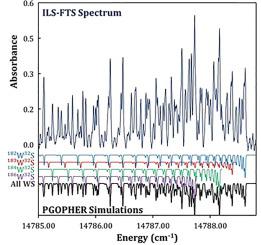当前位置:
X-MOL 学术
›
J. Mol. Spectrosc.
›
论文详情
Our official English website, www.x-mol.net, welcomes your feedback! (Note: you will need to create a separate account there.)
Observation and Analysis of a new [14.26]0+ – X 3Σ–0+ transition of WS, Observed using Intracavity Laser Spectroscopy with Fourier-Transform Detection
Journal of Molecular Spectroscopy ( IF 1.4 ) Pub Date : 2020-11-01 , DOI: 10.1016/j.jms.2020.111378 Jack C. Harms , Kristin N. Bales , James J. O'Brien , Leah C. O'Brien
Journal of Molecular Spectroscopy ( IF 1.4 ) Pub Date : 2020-11-01 , DOI: 10.1016/j.jms.2020.111378 Jack C. Harms , Kristin N. Bales , James J. O'Brien , Leah C. O'Brien

|
Abstract The (1,0), (0,1), and (1,2) bands of a new [14.26]0+ – X3Σ–0+ transition of WS are described. The WS molecules were produced in the plasma discharge formed when either a 0.15 A DC plasma current or a 0.80 A RF-pulsed DC plasma current was applied to a W-lined Cu hollow cathode in an atmosphere that was 0.1%CS2, ∼30% H2 and ∼70% Ar at a total pressure of 1 to 2 torr. The hollow cathode was located in the resonator cavity of either a Ti:Sapphire or dye laser (with DCM laser dye), causing molecular absorption to be superimposed upon the tunable broadband profile of the laser. This profile was detected using a Bruker IFS 125M spectrometer using an instrument resolution of 0.01 cm-1. Effective pathlengths for the ILS-FTS measurements were 170 m (Δv=+1) and 535 m (Δv=–1). The ILS-FTS spectra were rotationally analyzed using PGOPHER. Transitions of 182W32S, 183W32S, 184W32S, and 186W32S were identified for all three bands, and a mass-independent Dunham model was built in PGOPHER to fit the X3Σ–0+ ground state of WS. Experimental line positions from the laser induced fluorescence (LIF) spectrum of WS [Tsang et al., J. Mol. Spectrosc. 359 (2019) 31] and our analysis of the (1,0) band of the [13.10]1–X3Σ–0+ transition [Harms et al., J. Mol. Spectrosc. 372 (2020) 111349] were included in the PGOPHER fit. A correlation diagram between the experimentally observed states and those predicted ab initio [Tsang et al.] is used to shed light on the complex electronic spectrum of WS.
中文翻译:

WS 新的 [14.26]0+ – X 3Σ–0+ 跃迁的观察和分析,使用带傅立叶变换检测的腔内激光光谱法观察
摘要 描述了 WS 新的 [14.26]0+ – X3Σ–0+ 跃迁的 (1,0)、(0,1) 和 (1,2) 能带。在 0.15 A DC 等离子体电流或 0.80 A RF 脉冲 DC 等离子体电流在 0.1% CS2,~30% H2 和 ~70% Ar,总压力为 1 to 2 torr。空心阴极位于钛:蓝宝石或染料激光器(使用 DCM 激光染料)的谐振腔中,导致分子吸收叠加在激光器的可调谐宽带分布上。使用 Bruker IFS 125M 光谱仪使用 0.01 cm-1 的仪器分辨率检测该轮廓。ILS-FTS 测量的有效光程长度为 170 m (Δv=+1) 和 535 m (Δv=–1)。使用 PGOPHER 旋转分析 ILS-FTS 光谱。所有三个波段都确定了 182W32S、183W32S、184W32S 和 186W32S 的跃迁,并且在 PGOPHER 中建立了质量独立的 Dunham 模型以拟合 WS 的 X3Σ-0+ 基态。WS 激光诱导荧光 (LIF) 光谱的实验线位置 [Tsang et al., J. Mol. 光谱c。359 (2019) 31] 和我们对 [13.10]1–X3Σ–0+ 跃迁的 (1,0) 带的分析 [Harms 等人,J. Mol. 光谱c。372 (2020) 111349] 包含在 PGOPHER 拟合中。实验观察到的状态与那些从头开始预测的相关图 [Tsang 等人] 用于阐明 WS 的复杂电子光谱。WS 激光诱导荧光 (LIF) 光谱的实验线位置 [Tsang et al., J. Mol. 光谱c。359 (2019) 31] 和我们对 [13.10]1–X3Σ–0+ 跃迁的 (1,0) 带的分析 [Harms 等人,J. Mol. 光谱c。372 (2020) 111349] 包含在 PGOPHER 拟合中。实验观察到的状态与那些从头开始预测的相关图 [Tsang 等人] 用于阐明 WS 的复杂电子光谱。WS 激光诱导荧光 (LIF) 光谱的实验线位置 [Tsang et al., J. Mol. 光谱c。359 (2019) 31] 和我们对 [13.10]1–X3Σ–0+ 跃迁的 (1,0) 带的分析 [Harms 等人,J. Mol. 光谱c。372 (2020) 111349] 包含在 PGOPHER 拟合中。实验观察到的状态与那些从头开始预测的相关图 [Tsang 等人] 用于阐明 WS 的复杂电子光谱。
更新日期:2020-11-01
中文翻译:

WS 新的 [14.26]0+ – X 3Σ–0+ 跃迁的观察和分析,使用带傅立叶变换检测的腔内激光光谱法观察
摘要 描述了 WS 新的 [14.26]0+ – X3Σ–0+ 跃迁的 (1,0)、(0,1) 和 (1,2) 能带。在 0.15 A DC 等离子体电流或 0.80 A RF 脉冲 DC 等离子体电流在 0.1% CS2,~30% H2 和 ~70% Ar,总压力为 1 to 2 torr。空心阴极位于钛:蓝宝石或染料激光器(使用 DCM 激光染料)的谐振腔中,导致分子吸收叠加在激光器的可调谐宽带分布上。使用 Bruker IFS 125M 光谱仪使用 0.01 cm-1 的仪器分辨率检测该轮廓。ILS-FTS 测量的有效光程长度为 170 m (Δv=+1) 和 535 m (Δv=–1)。使用 PGOPHER 旋转分析 ILS-FTS 光谱。所有三个波段都确定了 182W32S、183W32S、184W32S 和 186W32S 的跃迁,并且在 PGOPHER 中建立了质量独立的 Dunham 模型以拟合 WS 的 X3Σ-0+ 基态。WS 激光诱导荧光 (LIF) 光谱的实验线位置 [Tsang et al., J. Mol. 光谱c。359 (2019) 31] 和我们对 [13.10]1–X3Σ–0+ 跃迁的 (1,0) 带的分析 [Harms 等人,J. Mol. 光谱c。372 (2020) 111349] 包含在 PGOPHER 拟合中。实验观察到的状态与那些从头开始预测的相关图 [Tsang 等人] 用于阐明 WS 的复杂电子光谱。WS 激光诱导荧光 (LIF) 光谱的实验线位置 [Tsang et al., J. Mol. 光谱c。359 (2019) 31] 和我们对 [13.10]1–X3Σ–0+ 跃迁的 (1,0) 带的分析 [Harms 等人,J. Mol. 光谱c。372 (2020) 111349] 包含在 PGOPHER 拟合中。实验观察到的状态与那些从头开始预测的相关图 [Tsang 等人] 用于阐明 WS 的复杂电子光谱。WS 激光诱导荧光 (LIF) 光谱的实验线位置 [Tsang et al., J. Mol. 光谱c。359 (2019) 31] 和我们对 [13.10]1–X3Σ–0+ 跃迁的 (1,0) 带的分析 [Harms 等人,J. Mol. 光谱c。372 (2020) 111349] 包含在 PGOPHER 拟合中。实验观察到的状态与那些从头开始预测的相关图 [Tsang 等人] 用于阐明 WS 的复杂电子光谱。



























 京公网安备 11010802027423号
京公网安备 11010802027423号